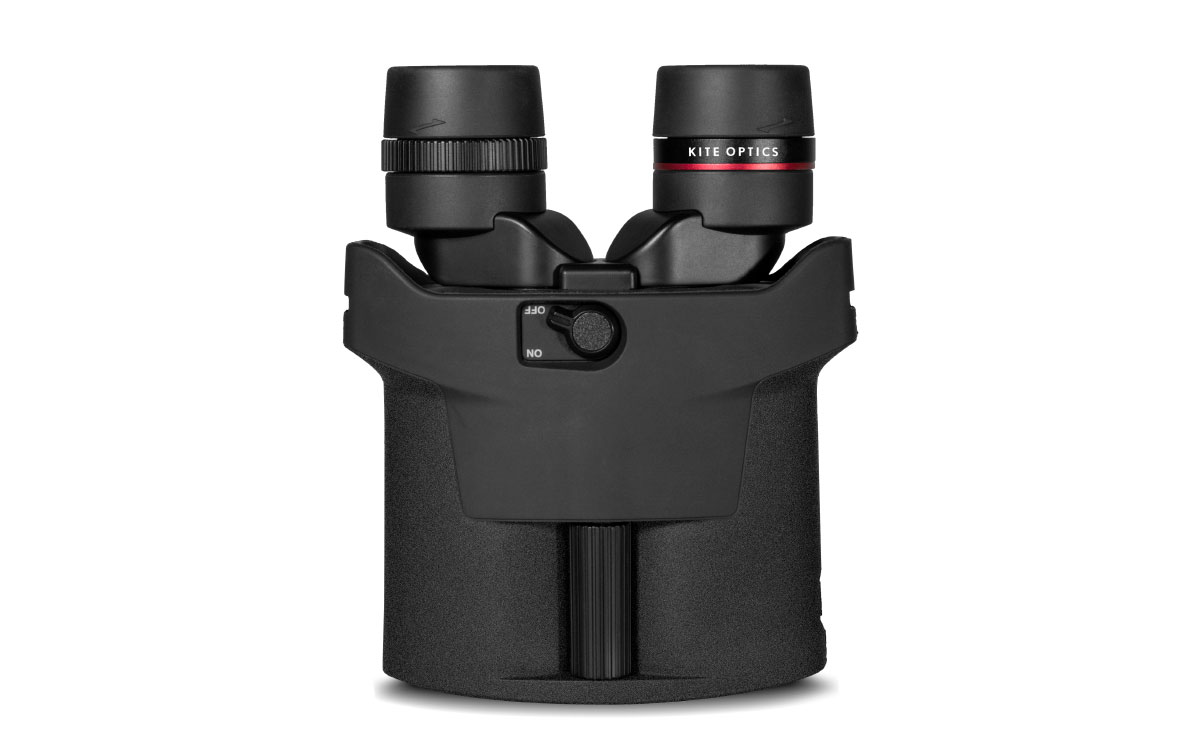Kite APC Stabilized 12x30 binocular
Kite's ever-expanding range of binoculars saw the addition of two new models in spring. In line with several other manufacturers, but at the same time upping the ante, the Belgian optics company has launched its APC Stabilized range, incorporating the latest technology in image stabilisation.
Comprising two 30 mm objective models with 10x and 12x magnification, the APC aesthetics are sleek and modern looking, combining ruggedness with unshakability of purpose. An immediately recognisable aspect common to image-stabilised binoculars – the oculars are positioned more widely apart than the objectives, resulting in a 'back-to-front' appearance – is surreptitiously hidden, disguised within the bodywork, which has been cleverly fashioned and designed to accommodate the two AA batteries required to power the system.

The outer protective casing is a combination of non-slip, textured rubber and polyethylene. This offers waterproofing to IPX6 standards, a recognised degree of protection provided by mechanical casings and electrical enclosures against intrusion of dust and high-pressure, heavy sprays of water. The casing houses a recessed switch near the oculars, which activates the stabilising system; an adjacent illuminated indicator tells the operator if the system is engaged.
There are no designated thumb-rests, but when holding to view and to adjust the focusing, I found my thumbs fell naturally into the long, shallow central indentation underneath the body. Focusing is achieved by rotating a narrow diameter central wheel, which is positioned at the objective end of the binocular. What this lacks in width it makes up for in its 4 cm length by offering comfortable accommodation for two or three fingers. Its position in the cleverly designed ergonomic body directs the hands away from the integrated rubber strap lugs so fingers can be kept comfortably straight and relaxed during operation.
Because there is no central hinge, the interpupillary distance is adjusted by a simultaneous swivel movement of both oculars. The soft rubber-covered eyecups twist out, click-stopping in three settings above the fully retracted position. There is a standard dioptre adjustment ring on the right ocular, which does not lock but stays firmly in place during use.
From an optical perspective, the APC works well and delivers the same performance level as Kite's mid-range Petrel binoculars. I was surprised by how bright the image was considering the combination of 12x magnification with a relatively small 30 mm objective. Colours, too, were well reproduced and the clarity and contrast easily passed muster.
A minor negative point was the obvious curvature of field in the image's narrow periphery, where sharpness was duly compromised. However, the level of chromatic aberration is low and, given the high magnification, the field of view is a relatively wide 91 m at 1,000 m; the close focus distance of 2.6 m is excellent.
But it is the simplicity and precision of the stabilisation system which will be key to this binocular's success. One very important component is the correction angle. The APC features new technology that allows the product to correct the image stability by 3°, or 5.3 m at a distance of 100 m. This translates to up to six times more than the 0.5° to 1° found in most of today's stabilised binoculars.
Furthermore, unlike the 'Vari-Angle Prism' stabilisation more traditionally used, the new technology in the APC is based on the 'gimbal' system, which has emerged over the last three years and has been developed for stabilising action videos shot with smartphones while the user is in motion.
Back in the field, with the stabilisation mode engaged, this binocular came into its own, allowing me to use it with just one hand in windy conditions, successfully view birds as a passenger in a moving car and while cycling (don't try this at home!) – all with a no-shake, rock-steady image at 12x magnification. There are more practical aspects for its use, some of which include seawatching on board a vessel on a choppy ocean, combating excessive wind and overcoming hand-shake through fatigue or tremor.
All this requires a power source, and the two AA batteries allow the binocular to run for up to 36 hours. In order to conserve power, the binocular is equipped with sensors that automatically put the electronics into sleep mode when not in use. The integrated Angle Power Control (APC), which gives the range its name, detects positioning so that when it is vertical, hanging from the neck or standing on a surface, it switches off. As soon as it moves into a more horizontal position, when viewing, the stabilisation kicks in again. A timer function ensures it switches off completely after 90 minutes, irrespective of position, and a low battery indicator gives advance warning of the need to replace the batteries.
This binocular is well designed, relatively light in weight and very easy to use. It comes with a soft and flexible articulated rainguard, a comfortable padded lanyard and a soft carry case. The objectives are deeply recessed, well protected and do not require individual lens caps.
Further info
- Price: £789
- Size: 165x133 mm
- Weight: 620 g
- Field of view: 91 m at 1,000 m
- Light transmission: 84%
- Close focus: 2.6 m
- Gas filled: no
- Waterproof: water resistant to IPX6
- Guarantee: 30 years (optics), 2 years (electronics)
Verdict
- Colours well produced
- Clear and contrasting image
- Obvious curvature of field


